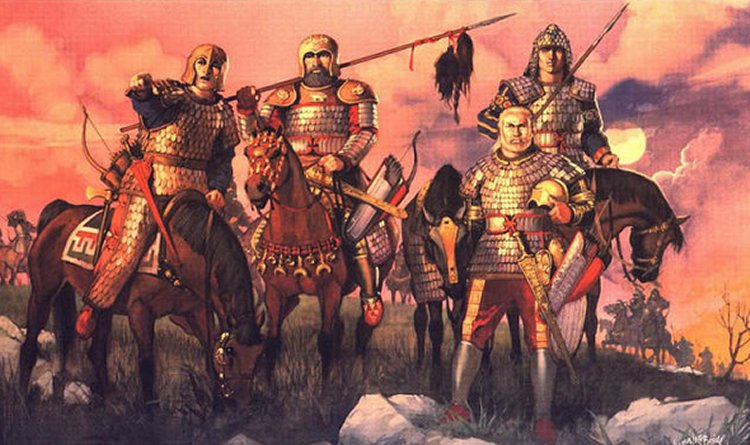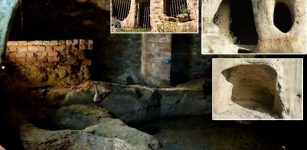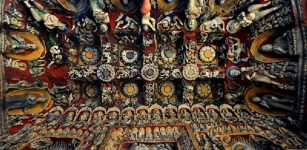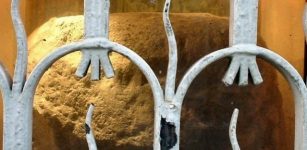Guardians Of The Mounds – Battle To Save Scythian Burial Mounds From Destruction Continues
Jan Bartek – MessageToEagle.com – To some, the ancient burial mounds are standing on a piece of land that can be used for building new homes and factories. To others like the group Guardians of the Mounds, the burial mounds of Scythians and other ancient warrior cultures are a cultural and historical legacy that must be preserved.
Founded two years ago members of the group Guardians of the Mound fight to save the ancient burials in Ukraine and the history of the Scythian as a cultural legacy.
Oleg being mourned by his warriors, an 1899 painting by Viktor Vasnetsov. This burial rite, with the funerary tumulus, is typical of both Scandinavian and Eurasian nomadic customs. Credit: Pubic Domain
There are about 100,000 burial mounds dot the fields in Ukraine, but many of them were flattened during the Soviet era. Now, these ancient burials face new dangers from grave robbers and farmers who sometimes also level burial mounds in their fields to ease plowing.
Despite many theories, the history of the Scythians is still unclear. From about 700 to 300 B.C. the Scythians suddenly appeared on the Eurasian steppes.
“Some modern scholars suggest three theories to explain their sudden and mysterious appearance. Some believe they migrated there from the north, others from the east, or perhaps from the south.
Although the geographic origins of the Scythian people are hotly debated, evidence for the time of their first appearance in history is not. They suddenly appeared at the same time and near the same area of the Israelites’ disappearance.
They are mentioned in the Bible and several other ancient sources. However, for some unknown reasons they vanished without a trace.” 1
Tracing the history of the Scythians has been difficult especially since these people did not have a written language, but a recent DNA study did shed some light on their origin.
“The results reveal that substantial genetic turnovers were associated with the decline of the long-lasting Bronze Age sedentary groups and the rise of Scythian nomad cultures in the Iron Age. Following the relatively homogenous ancestry of the late Bronze Age herders, at the turn of the first millennium BCE, influxes from the east, west, and south into the steppe formed new admixed gene pools.
The Scythians were feared and admired for their prowess in war and, in particular, for their horsemanship. They were among the earliest people to master the art of riding, and their mobility astonished their neighbors.
Scientists were able to identify at least two main sources of origin for the nomadic Iron Age groups. An eastern source likely originated from populations in the Altai Mountains that, during the course of the Iron Age, spread west and south, admixing as they moved.
These genetic results match with the timing and locations found in the archeological record and suggest an expansion of populations from the Altai area, where the earliest Scythian burials are found, connecting different renowned cultures such as the Saka, the Tasmola, and the Pazyryk found in southern, central and eastern Kazakhstan respectively. Surprisingly, the groups located in the western Ural Mountains descend from a second separate, but the simultaneous source.” 2
If the burial mounds of the Scythians are destroyed it will be impossible to learn more about these people who according to ancient Greek sources are one of the oldest nations on Earth.
According to one archaeological theory, Scythians’ burial mounds served a much greater purpose than merely being a place where the deceased was put to rest. Living on The burial mounds were barriers against invaders and a symbol the area was inhabited by a strong group of people. One can say the Scythians’ burial mounds were a military symbol used to frighten possible attackers.
Many ancient burial mounds in Ukraine have been either looted or destroyed. Credit: Public Domain
Oleksandr Klykavka, founder of the preservation group, Guardians of the Mounds emphasizes finding gold treasures in a mound does not justify dismantling it.
Klykavka says “gold items and funerary goods displayed by the thousands at museums in Kyiv, the capital, are mere distractions from the message of the mounds.” 3
Not everyone is convinced Klykavka’s arguments are valid though.
Dmytro Teslenko, the chief archaeologist for the city of Dnipro argues criticism by the Guardian of the Mounds is misplaced.
“New techniques for studying the sites, like the DNA analysis of remains, is turning up interesting clues about Ukraine’s ancient history, he said, adding that some of the mounds would be destroyed anyway and should be studied first. The site he is working on, he said, will become a park in a new country home development.
Oksana Lifantiy, an expert on Scythian culture at the Museum of Historical Treasures in Kyiv, said the Guardians of the Mounds should lobby the government on zoning laws, not criticize archaeologists.
If archaeologists are prohibited from excavating, she said, “we will lose not only cultural memorials but also historically valuable information” as local governments approve construction on the sites anyway.”3
Many burial mounds in Ukraine have been robbed and it is not uncommon to find “new bodies” that have been placed in these ancient mounds.
“The Dnipro mound dates to a prehistoric Indo-Iranian culture. But the main catacomb, about 15 feet below the surface, is more recent, having been built around the 4th century B.C. Near the top, the archaeologists found an even more recent intruder: a coffin emblazoned with a red star, which they ascertained contained a Communist Party boss of a local collective farm, who had himself interred in the mound in 1932. The Soviet government also buried World War II heroes in one Scythian mound in Ukraine, placing a Soviet monument on top.
Many valuable and beautiful objects like this one have been found in Scythian burial mounds This is a gold Scythian pectoral, or neckpiece, from a royal kurgan in Tolstaya Mogila, Pokrov, Ukraine, dated to the second half of the 4th century BC. Credit: Public Domain
Plunder of the Scythian burial mounds began in the Scythian era and remains lucrative today. The police mostly ignore the activity, according to Oleksandr Panfyonov, a member of the Guardians of the Mounds. Flea markets in Kyiv offer cheap antiquities from burial mounds, such as ceramics. More valuable funerary goods are sold on online auction sites.
“It’s painful to see,” Dr. Lifantiy, the expert on Scythian culture, said of the online sale of goods that appear authentic to her.
“All over Ukraine, registered archaeological monuments are already being demolished, built up and given to private ownership,” said Anton Korvin-Piotrovsky, a member of the board of the Union of Archaeologists of Ukraine. “It happens with the tacit consent or with the active participation of local bodies of cultural heritage protection,” which are eager to excavate for the possibility of finding funerary goods and less concerned about the actual dirt piles.”
See also: More Archaeology News
This leaves us with the question of whether preserving the Scythian burial mounds is more important than retrieving the ancient skeletons and burial goods hidden inside.
It would naturally be ideal if scientists could achieve both of these goals, but it may be a difficult task.
Written by Jan Bartek – MessageToEagle.com – AncientPages.com Staff Writer
Expand for references- Sutherland – Mysterious Disappearance of Scythians Still Remains Unsolved, AncientPages.com
- Conny Waters – Will Ancient DNA Unravel History Of The Scythians From Central Asian Steppe? AncientPages.com
- Maria Varenikova and Andrew E. Kramer – Ukraine’s ancient burial mounds offer meaning in a heap of history, New York Times














